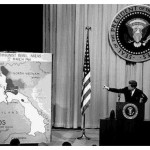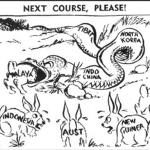
American involvement in Vietnam began during World War II, increased in the 1950s and reached its peak in the late 1960s. The United States’ interest in Asia escalated in late 1941, after Japanese planes attacked Pearl Harbour and Washington responded by declaring war on Japan. The Viet Minh was formed the same year, as an underground movement to resist both the French and Japanese. By 1944, agents of the Office of Strategic Services (OSS), the forerunner to the Central Intelligence Agency (CIA), were operating in southern China and northern Vietnam. These agents formed a working alliance with Ho Chi Minh and the Viet Minh, who assisted with safeguarding and repatriating American pilots downed over Vietnamese territory. In return, the OSS supplied Ho’s men with weapons and equipment. It was an arrangement based on wartime expedience rather than political similarities. Nevertheless, Ho Chi Minh nurtured some hope that cooperating with the United States might bring about Washington’s support for an independent post-war Vietnam. When Ho attempted to initiate Vietnamese independence in late 1945, he drew heavily on the United States’ own Declaration of Independence, citing its Enlightenment values of nationalism, popular sovereignty and self-determination. The Viet Minh leader hoped to demonstrate that his own political values were not far removed from those of the US.
After 1945, American involvement in Vietnam was driven and shaped by the Cold War. American foreign policy was largely shaped by the Truman Doctrine (1947), which held that communism must be contained and that governments susceptible to communist infiltration and takeover must be assisted. If this did not occur then communism would expand its global reach, jumping from one nation to its neighbours (the Domino Theory). This particularly relevant to Asia, where national governments were weaker and borders were poorly controlled; Asian nations, therefore, had a lower capacity for resisting communist infiltration and invasion. Having spread from China to North Korea, American planners believed that communism would continue its movement further south to nations like Vietnam, Laos, Cambodia, Thailand, Burma, Malaya and Indonesia. If these countries fell then communists would rule more than one-quarter of the globe: from East Germany to the shores of the Pacific Ocean. These fears were espoused by US vice president Richard Nixon, speaking in December 1953:
“Let us turn now to another area of the world: Indochina. And many of you ask this question: Why is the United States spending hundreds of millions of dollars supporting the forces of the French Union in the fight against communism in Indochina? If Indochina falls, Thailand is put in an almost impossible position. The same is true of Malaya, with its rubber and tin. The same is true of Indonesia. If this whole part of south-east Asia goes under communist domination or communist influence, Japan, who trade and must trade with this area in order to exist, must inevitably be oriented towards the communist regime. That indicates to you and to all of us why it is vitally important that Indochina not go behind the Iron Curtain.”

From 1947 the United States, determined to halt the growth of communism in Asia, backed the return of the French in Vietnam. This was not universally popular with Americans, many of whom despised colonialism and believed that Asian nations should be free to govern themselves. But in Washington, the revival of French colonialism in Indochina was seen a lesser evil than communist-ruled Vietnam. France, after all, was a democratic capitalist state and an important Cold War ally. The Viet Minh, on the other hand, could not be trusted. The movement was riddled with communists and both its motives and political loyalties were unclear. The US considered Ho Chi Minh to be unreliable and possibly deceitful. He mouthed the slogans of a nationalist but Washington considered him a communist. There was some evidence to support this view, such as Ho’s work within the Soviet Union, the Comintern and the Chinese Communist Party.
In late 1945 Washington’s formal position on Vietnam was vague, however, by early 1947 the US was tacitly supporting France. Later that year US president Harry Truman authorised a moderate amount of funding ($160 million) to assist the French war effort. American administrators also turned a blind eye when Paris diverted some Marshall Plan funds to supply the war in Indochina. By 1951 US military aid to the French had tripled to $450 million; by 1953 it was up to $785 million. French forces in Vietnam were using ships and aircraft on loan from the US. CIA agents were conducting covert operations in Vietnam in support of the French, like carrying out 700 supply drops to CEFEO troops trapped at Dien Bien Phu (1954). By the time French forces surrendered to the Viet Minh in mid-1954, Washington had invested almost $3 billion in ‘saving’ Indochina from the spectre of communism.

The French surrender at Dien Bien Phu and France’s withdrawal from Vietnam triggered greater US involvement there. American delegates attended the Geneva conference of April-July 1954, however, they did not sign the final agreement. Washington by then had decided to back a nationalist, democratic state in southern Vietnam. With American aid and support, South Vietnam would provide a buffer against communists further north. The Geneva Accords (1954) arranged for a two-year division of Vietnam until elections and reunification in 1956; the Americans wanted this temporary division to become permanent. Washington searched for an indigenous Vietnamese leader with pro-Western, anti-communist values to take charge in South Vietnam. They found a candidate in Ngo Dinh Diem, a minor political figure who had been living in North America since 1951. American politicians and policymakers took a shine to Diem; he seemed exactly the person needed to lead South Vietnam and transform it into a bulwark against communism. In 1954 the US parachuted Diem into power, persuading Vietnamese emperor Bao Dai to appoint him prime minister. Diem was provided with massive American support: recognition, intelligence, money, trade deals, military equipment and training.
“The US government became involved in Vietnam slowly. Each step of the way, for more than 20 years, policy-makers debated options, considered alternatives, and ultimately chose deeper involvement. By mid-1965, a series of incremental steps led to US ground troops facing combat in Vietnam. By 1968 the war had become a quagmire with no clear road to victory. Only in 1973, after laying waste to Vietnam and suffering massive casualties, would the United States ingloriously pull out the last of its troops. America’s longest war tore the nation apart.”
David R. Farber, historian
America’s mission in Vietnam now hinged on two things: Ngo Dinh Diem becoming a credible and effective leader, and North Vietnam accepting the north-south division of Vietnam. By the end of the 1950s, it was clear that neither had occurred. The US government’s state-building program in South Vietnam had not succeeded. South Vietnam was largely a failed state, ruled by brutal nepotists and propped up by American aid. The South Vietnamese military had grown and developed considerably but was still incapable of defending the new nation. Meanwhile in Hanoi, the Lao Dong government was plotting to achieve reunification by stealth. In the late 1950s, communist insurgents unleashed a wave of terror attacks in South Vietnam, attacking government forces, facilities and figures. It was clear that a war between North and South Vietnam was imminent. American policy in the 1950s and early 1960s sought to avoid direct military involvement in Vietnam – but the worsening situation there, coupled with the arrival of a new president, would lead to a significant change in tactics.

1. The United States showed little interest in Vietnam until World War II, when American agents worked with the Viet Minh against Japanese occupiers. Ho Chi Minh hoped this collaboration would convince the US to back Vietnamese independence.
2. After the war Washington became concerned that Vietnam, among other Asian nations, was susceptible to communist infiltration and takeover. This view was informed by the Cold War, the Truman Doctrine and the Domino Theory.
3. Despite some misgivings about backing a colonial power, the US began to support the French in Vietnam. Washington aided the French during their war with the Viet Minh, investing almost $3 billion in the years prior to 1954.
4. The French withdrawal led to direct US involvement in Vietnam. The US did not sign the Geneva Accords and preferred to support the formation of a democratic South Vietnam, to serve as a buffer against communists in the North.
5. In 1954 the US parachuted Ngo Dinh Diem into the leadership of South Vietnam. American attempts to create a viable nation state failed, and by the early 1960s South Vietnam was at risk of infiltration and invasion by communists.
© Alpha History 2016. Content on this page may not be republished or distributed without permission. For more information please refer to our Terms of Use.
This page was written by Jennifer Llewellyn, Jim Southey and Steve Thompson. To reference this page, use the following citation:
J. Llewellyn et al, “US involvement in Vietnam”, Alpha History, accessed [today’s date], https://alphahistory.com/vietnamwar/us-involvement-in-vietnam/.
